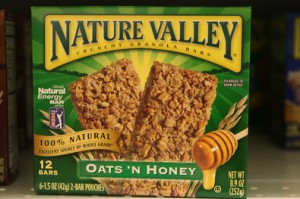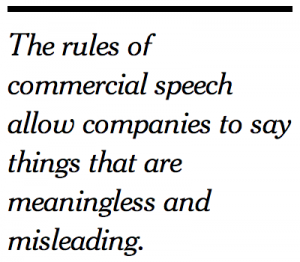Introduction
 Though the “organic” label has been strictly defined and regulated since 2002, the Food and Drug Administration has declined to define the frequently used term “natural.”
Though the “organic” label has been strictly defined and regulated since 2002, the Food and Drug Administration has declined to define the frequently used term “natural.”
The F.D.A.’s nonbinding advisory opinion states that “natural” means “nothing artificial or synthetic (including colors regardless of source)” or anything in the product that “would not normally be there,” but this opinion cannot be legally enforced. (Crystal Light Natural Lemonade, for instance, has artificial color but no lemon in its ingredients.)
Still, many Americans remain confused about foods that are marketed as “natural” products.
Should the F.D.A. define “natural”?
Discussion
F.D.A. Must Define, and Enforce, the Term “Natural”
 Robert Lustig, a pediatric endocrinologist and member of the Institute for Health Policy Studies at the University of California, San Francisco, is the president of the Institute for Responsible Nutrition. Marsha Cohen, a law professor at the University of California Hastings, is the executive director of Lawyers for America.
Robert Lustig, a pediatric endocrinologist and member of the Institute for Health Policy Studies at the University of California, San Francisco, is the president of the Institute for Responsible Nutrition. Marsha Cohen, a law professor at the University of California Hastings, is the executive director of Lawyers for America.
Whenever food comes with a health claim on its label, exercise caution. Can Cocoa Krispies really “support immunity” because some Vitamin C was added? Does a box of Cheerios “reduce cholesterol” because it contains some cereal fiber? You can thank the Supreme Court for this hyperbole, because the rules of commercial speech allow companies to say things that are meaningless.
 Perhaps the most pernicious of all health claims is “natural.” The term is highly confusing to consumers, many of whom conflate it with the word “organic,” a term defined by law, though “natural” is not. Others think it just means “healthy.”
Perhaps the most pernicious of all health claims is “natural.” The term is highly confusing to consumers, many of whom conflate it with the word “organic,” a term defined by law, though “natural” is not. Others think it just means “healthy.”
Is a Dole fruit cup “natural,” even though it contains added ascorbic and citric acid, possibly synthetically produced? And what about foods with high-fructose corn syrup? That ingredient came from corn — which is technically “of nature” — but the finished product was made in a lab. Refined sugar is no better. It’s been acidified and bleached. But many would accept sugar as “natural,” despite the scientific evidence that excessive amounts can be harmful.
And then there is the grey area of “natural flavors,” which can simply signify added sugar. For example, there are 11 grams of sugar in a serving of Kashi GoLean Crisp! Toasted Berry Crumble cereal but the box advertises that the product is “naturally sweetened.” Dried cane syrup is the third ingredient (by weight), and both the cranberries and the blueberries are sweetened with cane syrup. Is that still what a consumer defines as “naturally sweetened?”
The F.D.A.’s guidance has no teeth. Without a government definition, “natural” is inherently misleading because consumers purchase products under misconceptions about their contents. But as companies oppose banning the use of the word “natural” as a violation of “commercial speech,” the F.D.A. has no choice but to issue an industry-wide definition and then enforce it.
Perhaps the best way to define “natural” would be to define the amount of processing allowed “post-harvesting.” For example, a food grown with pesticides could not be labeled “organic” but it could be deemed “natural.” Organic food processed with preservatives could not be labeled “natural.”
Correction: An earlier version misstated how “organic” is defined. Organic refers to both the pre-harvesting and post-harvesting process.
You can find the whole debate here.
11.11.2014
Source: The New York Times




